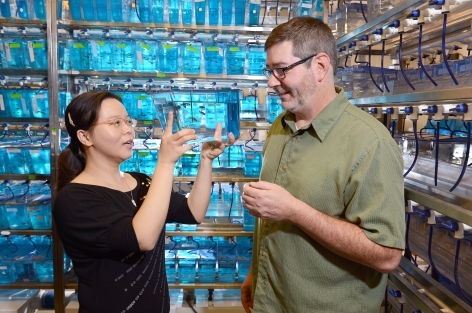
Ying Wang, left, and Jeffrey Essner, right, are breaking ground in advancing techniques to edit the genes of zebrafish. Larger photo. Photo by Robert Elbert.
AMES, Iowa – Iowa State University researchers are helping to advance new techniques that allow scientists to site-specifically mutate and edit the genes of living organisms.
The two researchers, co-authors of a study published this week in the journal Nature, are breaking ground in making custom changes to the genome of live zebrafish by utilizing site-directed molecular scissors known as transcription activator-like effector nucleases (TALENs).
Through the TALENs system, researchers for the first time are able to cut out portions of zebrafish DNA and insert artificial replacements. That allows researchers to deactivate – and possibly activate – targeted genes, opening new possibilities to study genetics during early development as well as adult life.
The innovation could have sweeping applications in agriculture and the study of human disease, said Ying Wang, a postdoctoral research associate in genetics, development and cell biology and one of the co-first authors of the study.
“This work has very far-reaching implications on many fronts,” Wang said. “It could lead to more effective disease resistance in crops and production animals, and it has the potential to offer new insights into human genetics and human disease.”
The zebrafish is a small, freshwater species, usually only a few centimeters in length, that wouldn’t look out of place swimming around a pet store aquarium. The ISU researchers keep about 8,000 of them in tanks on campus to conduct their research, and, despite their common appearance, zebrafish possess several traits that make them ideal model organisms for genetic study.
For instance, zebrafish embryos are fertilized outside of the mother’s body, where they are easy to collect and study, said Jeffrey Essner, an associate professor of genetics, development and cell biology and a co-author of the paper. The embryos are also transparent and can be studied easily under a microscope, Essner said. Finally, a single zebrafish can spawn up to 400 embryos in a single day, providing plenty of material for studies of gene manipulation.
Essner said zebrafish share roughly 90 percent of their genetic makeup with humans, so studying their development can shed new light on human disease. That’s especially true during the early embryonic stages of development, he said.
“Most cancers are caused by sporadic mutations in genes over time,” Essner said. “What we’re doing here could lead to the ability to manipulate those genes, even in an adult.”
The ability to activate zebrafish genes – essentially switching them on and off – could lead to breakthroughs in treatments for cancer and a range of other diseases in humans and animals, he said.
Wang and Essner contributed to a team of 16 credited co-authors on the paper, which was led by Stephen Ekker, a molecular biologist at the Mayo Clinic in Rochester, Minn. The paper, titled “In vivo genome editing using high-efficiency TALEN systems,” describes the team’s effort to make TALENs technology more efficient and to create precise gene-editing techniques.
The TALENs technology has roots at Iowa State, Wang said. Adam Bogdanove, a former ISU professor of plant pathology and microbiology, laid much of the groundwork for the techniques utilized for the paper along with Dan Voytas, also a former ISU professor; Bing Yang, an assistant professor of genetics, development and cell biology; and Martin Spalding, a professor of genetics, development and cell biology.
Since then, TALENs technology has been used to manipulate the genetics of cells, but Essner said that Ekker's group is the first to use TALENs to edit genes in vivo, meaning in a living organism. The paper is the product of more than a year of collaboration among the 16 co-authors, requiring monthly webinars and close cooperation, he said.
“We’re just thrilled to have been part of this collaborative effort,” he said. “We can’t wait to move forward and continue to perfect these gene editing techniques.”